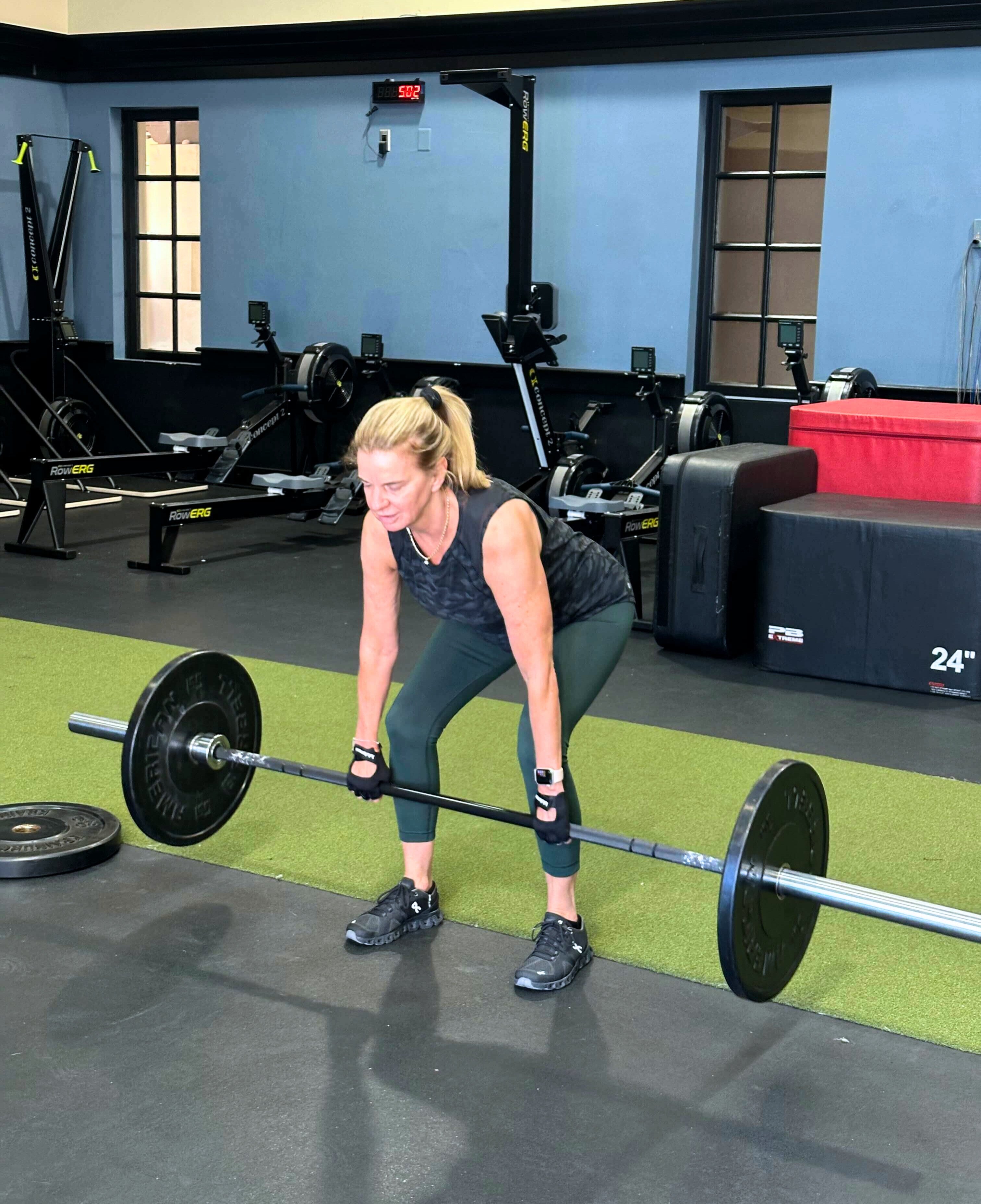How to deadlift like a pro — 7 variations of the deadlift
October 30th, 2024 | 5 min. read

Weightlifting is not just for young buff guys who busily lift and flex in front of the mirrors at the local gym. Weightlifting is a necessary exercise for people of all ages, genders, and abilities.
Weightlifting builds muscle mass, increases bone density, and can drastically improve your functional fitness level. Deadlifts are one of the simplest movements, yet the list of benefits is miles long (ok, maybe not quite miles).
You’ve likely heard of the deadlift, but did you know there are seven types of deadlifts? Do you know how to execute them safely?
In this article, you will learn why the deadlift is a cornerstone movement, what muscles it targets, the seven variations of the deadlift, and recommended rep schemes.
 Why is the deadlift such a cornerstone movement?
Why is the deadlift such a cornerstone movement?
The deadlift is a cornerstone movement in strength training for several reasons.
Scalable
You can easily scale deadlifts to adapt to different fitness levels by changing the weight and depth of the movement. Scaling makes it suitable for beginners and advanced lifters alike providing a progressive way to build strength over time.
Full body activation
Deadlifts require coordination and activation of various muscle groups, including stabilizers. This full-body effort helps you burn more calories and improve overall athletic performance.
Compound exercise
The deadlift targets multiple muscle groups at the same time, including the back, glutes, hamstrings, quads, and core. It is an efficient exercise for building overall strength and muscle mass.
 Functional movement
Functional movement
The deadlift mimics everyday activities, such as picking objects up from the ground. This functional exercise helps in improving real-world strength and body mechanics, which is beneficial for everyday life, playing sports, and minimizing the chance of injury.
Posterior chain development
The deadlift is one of the best exercises for developing the posterior chain, which includes the hamstrings, glutes, and lower back. A strong posterior chain is crucial for athletic performance, especially in pickleball and tennis, injury prevention, and maintaining good posture (and a cute bottom).
What are the 7 variations of the deadlift?
 Conventional Deadlift
Conventional Deadlift
How to do it: Begin by placing your feet hip-width apart with the bar over your midfoot. Grip the bar just outside the legs while maintaining a neutral spine. Brace your core, push through your heels, and keep the bar close to your body. Drive your hips forward at the top, then lower the bar with control while maintaining a flat back.
The area it targets: This deadlift works the entire posterior chain, including the glutes, hamstrings, lower back, and traps.
 Sumo Deadlift
Sumo Deadlift
How to do it: This deadlift is similar to the standard deadlift, except you step your feet wide apart (sumo stance) and grip the bar with your hands inside your legs. Make sure to squeeze your glutes at the top and lower the bar with control.
The sumo deadlift’s wider stance shifts some of the load from the lower back to the legs, making it a great option for lifters looking for an alternative to the conventional deadlift or those with lower back sensitivities. It is also popular among powerlifters who find that the reduced range of motion in the sumo stance allows them to lift heavier weights.
The area it targets: Multiple muscle groups engage during this lift, including the quadriceps, adductors, glutes, hamstrings, traps, rhomboids, erector spinae, core, forearms, and grip muscles.
 Romanian Deadlift (RDL)
Romanian Deadlift (RDL)
How to do it: The RDL is just like the conventional deadlift, except when you lower the bar, you do not touch the weighted plates to the ground. Instead, you wait until you feel a stretch in the hamstrings, then return to standing, gliding the bar along your shins and thighs.
The area it targets: RDLs work your hamstrings, glutes, lower back (erector spinae), core, and upper back.
 Stiff-Legged Deadlift
Stiff-Legged Deadlift
How to do it: Perform a Romanian deadlift, but do not bend your legs. Keep them as straight as possible. You will need to lift lighter with this form of deadlift. It is a great movement for firing up your hamstrings.
The area it targets: Hamstrings and glutes.
 Trap/Hex Bar Deadlift
Trap/Hex Bar Deadlift
How to do it: Select a trap or hex bar instead of a regular barbell with this deadlift. Place your feet shoulder-width apart inside the hex bar. Use a neutral grip on the handles. Drive through your heels and keep your chest up. Brace your core to maintain stability and protect your lower back. Stand up straight at the top and hinge at the hips to lower the bar.
The hex bar deadlift offers a balanced mix of lower and upper-body engagement with a reduced risk of lower back strain. It’s an excellent alternative for those who may find the conventional deadlift challenging or uncomfortable, and it allows for a more natural lifting motion with a vertical torso. This makes it a popular choice for athletes aiming for explosive power and strength development.
The area it targets: Your quadriceps, glutes, hamstrings, lower back, traps, and core are engaged for this lift.
 Deficit Deadlift
Deficit Deadlift
How to do it: A deficit deadlift is a conventional deadlift performed while standing on an elevated surface, usually a weighted plate. This version is more challenging and puts a bigger workload on the quads.
The area it targets: Glutes, lower back, quads, hamstrings, adductors, traps, and forearms are active.
 Single Leg Deadlift
Single Leg Deadlift
How to do it: Single-leg deadlifts are typically performed using a kettlebell or dumbbell. Balance on one leg and extend the second leg behind you. Lean forward, slightly bending the active leg so your body looks like a T. Grasp your weight and engage your glutes to come back up to a standing position.
The area it targets: The SLD is great for your glutes, but it also targets your hamstring, calf, core, and erector spinae.
How should people approach the weight and rep scheme of a deadlift?
The choice between using lighter weights with more reps or heavier weights with fewer reps depends on the individual’s fitness goals.
Lighter weight and more reps
Beginners should focus on learning proper form and technique, which is crucial for a complex movement like the deadlift. One or two sessions per week allow beginners to practice without overloading their nervous system or risking injury due to fatigue or improper form. This approach will also build muscle endurance and hypertrophy (increased muscle mass).
Recommended rep scheme: 12-20 reps per set, 2-5 sets per workout.
Heavier weight and fewer reps
Working up to deadlifting with heavier weights shifts the focus to strength and power. Heavy lifts force you to recruit more muscle groups, such as your deep core muscles. This is key for athletes or anyone looking to boost their overall strength and capacity to lift more.
Training with heavier weights is also beneficial for developing power, which is the ability to exert force quickly. This is crucial for sports and activities requiring short bursts of strength.
Heavier weights create more load on the skeletal system, which can help improve bone density over time, reducing the risk of osteoporosis.
Recommended rep scheme: 1-5 reps per set, 3-6 sets per workout.
 How to incorporate both approaches
How to incorporate both approaches
A balanced approach for well-rounded fitness uses both lighter and heavier weights in your training routine.
You’ll develop different slow-twitch muscle fibers for endurance and fast-twitch for power. Mixing up the rep ranges and weight levels can keep workouts engaging and prevent the body from adapting too much to a specific load, avoiding strength or muscle growth plateaus.
Alternating between heavy days (which are more taxing on the nervous system) and lighter days (which allow for recovery while maintaining activity) helps maintain consistency without overtraining.
How often should people perform deadlifts?
Beginners and people maintaining general fitness should perform at least one deadlift variation one to two times a week. Intermediate and more advanced powerlifters can deadlift one to three times a week, depending on their goals.
Getting stronger at the Paseo Club
The more that strength training is studied, the more we learn how essential it is to implement into our weekly fitness routine.
The Paseo Club has over 10,000 square feet of gym space with a full selection of cardio and weight machines, free weights, including barbells and plates, dumbbells, and kettlebells, and stretching and mobility accessories.
If you want to learn more about how to strength train, join one of the Paseo Club’s small group training programs. The Greatest Results, Tribe HIIT Core, Tribe Functional Fitness, and Womens Strength Training are classes specifically developed to help you get stronger safely and progressively. Enjoy the small class size and custom guidance from your coach.
The Paseo Club offers dozens of ways for you to be active. Enjoy tennis, pickleball, swimming, Pilates, yoga, cycling, and much, much more. If you are not yet a member, then join today. Signing up takes mere minutes, and then you can join us for all activities, social events, and luxurious amenities. We can’t wait to see you soon!

